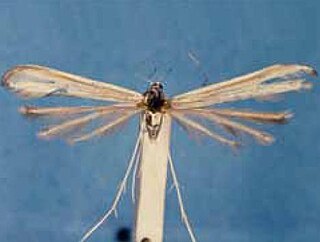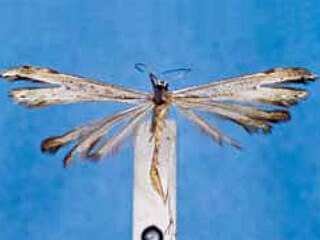
The cinereous bunting is a bird in the bunting family Emberizidae, a passerine family now separated by most modern authors from the finches, Fringillidae. This species was first described by Christian Ludwig Brehm.
Anoncia is a genus of moths in the family Cosmopterigidae.
Paraplatyptilia petrodactylus is a moth of the family Pterophoridae that is found in North America.

Hellinsia homodactylus is a moth of the family Pterophoridae. It is found in North America and Guerrero in Mexico.
Hellinsia gratiosus is a moth of the family Pterophoridae. It is found in North America

Hellinsia agraphodactylus is a moth of the family Pterophoridae. It is found in the Dominican Republic. Records from North America are probably a misidentification.
Oidaematophorus cineraceus is a moth of the family Pterophoridae. It is found in North America.
Oidaematophorus baroni is a moth of the family Pterophoridae that is found in North America.

Hellinsia phlegmaticus is a moth of the family Pterophoridae. It is found in Mexico and Guatemala.
Anoncia crossi is a moth in the family Cosmopterigidae. It was described by David Adamski in 1989. It is found in Mexico (Guerrero).
Compsoctena connexalis is a moth in the family Eriocottidae. It was described by Francis Walker in 1863. It is found in South Africa.
Dichomeris lypetica is a moth in the family Gelechiidae. It was described by Walsingham in 1911. It is found in Mexico (Guerrero).
Compsolechia metadupa is a moth of the family Gelechiidae. It was described by Walsingham in 1910. It is found in Mexico (Tabasco).
Compsolechia succincta is a moth of the family Gelechiidae. It was described by Walsingham in 1910. It is found in Mexico (Tabasco) and Jamaica.
Anacampsis lapidella is a moth of the family Gelechiidae. It was described by Thomas de Grey in 1897. It is found in the West Indies (Grenada).
Glyphidocera umbrata is a moth in the family Autostichidae. It was described by Walsingham in 1911. It is found in Guatemala.
Antaeotricha umbriferella is a moth in the family Depressariidae. It was described by Francis Walker in 1864. It is found in Amazonas, Brazil.
Antaeotricha admixta is a moth in the family Depressariidae. It was described by Lord Walsingham in 1913. It is found in Mexico (Guerrero).
The cinereous owl or Mexican barred owl, is an owl that is endemic to Mexico.
In organic chemistry, the Conia-ene reaction is an intramolecular cyclization reaction between an enolizable carbonyl such as an ester or ketone and an alkyne or alkene, giving a cyclic product with a new carbon-carbon bond. As initially reported by J. M. Conia and P. Le Perchec, the Conia-ene reaction is a heteroatom analog of the ene reaction that uses an enol as the ene component. Like other pericyclic reactions, the original Conia-ene reaction required high temperatures to proceed, limiting its wider application. However, subsequent improvements, particularly in metal catalysis, have led to significant expansion of reaction scope. Consequently, various forms of the Conia-ene reaction have been employed in the synthesis of complex molecules and natural products.



